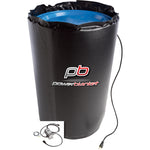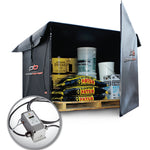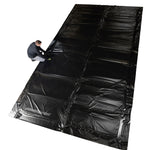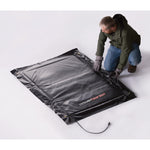You have no items in your shopping cart.
How to Cure Epoxy Resin for Maximum Strength
Article At-a-Glance
How Does Heating Affect Epoxy Resin Curing?
Heating epoxy resin accelerates the curing process by enhancing the chemical reaction between the resin and hardener, resulting in a stronger and more durable finish, with optimal curing temperatures ranging from 250°F to 300°F depending on the epoxy type.
Key Takeaways
- Understand Temperature's Role: Heating epoxy resin accelerates curing by enhancing the chemical reaction, resulting in a stronger bond. Optimal temperatures range from 250°F to 300°F, depending on the epoxy type.
- Methods for Applying Heat: Use heat lamps, heated surfaces, or curing blankets to manage heat during projects. These methods are especially useful in cold weather or for specific project needs.
- Avoid Common Pitfalls: Be cautious of overheating, which can cause yellowing, discoloration, or harmful fumes. Proper temperature control ensures a high-quality finish without warping or over-curing.
- Curing Timeframes: One-component epoxies cure faster at higher temperatures, while two-component epoxies require longer. Ensure the environment remains stable for up to 72 hours for optimal results.
- Best Practices for Success: Prepare surfaces properly, measure components accurately, and follow manufacturer guidelines to achieve maximum strength and durability in your epoxy resin projects.
Epoxy resin will reach maximum strength with the correct application of heat. Read on to learn how heat can help your epoxy resin cure as strong as possible.
What is epoxy resin, and why do you need to cure it for maximum strength?
Simply put, epoxy resin is a two-part adhesive material used to bond surfaces together. It needs to be cured to achieve maximum strength. Epoxy resin is strong and durable, making it ideal for bonding metal, glass, ceramic, and plastic. It can also be used to fill cracks and holes. Epoxy resin is available in various formulations, so it is important to choose the right one for your project.

Epoxy resin can be used in many different ways.
There are many common epoxy resin curing applications. Epoxy resin is in almost everything we use, from computer hardware and skateboards to boat hulls and windmills. The adhesive (resin) becomes rock hard after two substances combine. These two substances are epichlorohydrin, an epoxide, and bisphenol-A, a polyamine. Adding the polyamine to the resin base of epoxide causes a chemical reaction that hardens the mix. During the hardening process, called curing, the molecules form a crisscross pattern creating a solid bond.

Adding products called thermoplastic polymers increases the hardness and strength. There are different types of epoxies, depending on their use. During curing, the temperature, the resin, and the hardening compound affect the hardness.
The different ways to cure epoxy resin
There are several ways to cure the epoxy resin. The most common method is to use an oven or a heat lamp. Another option is to use a chemical curing agent, where the chemical interactions create heat. This can be tricky, so it is important to follow the instructions carefully. But as newer innovations have come about, more efficient and useful options have become available, such as heated curing blankets.

How long does each curing method take?
Curing epoxy resin takes an average of one week to cure (7 days) regardless of curing method. However, much like concrete, it takes much less than that for epoxy to be safe to walk on. After about 12 hours, the epoxy has cured enough to be walked on. After 24 hours, it’s ready for light use, and 72 hours for more heavy use. No matter what you’re doing with your epoxy project, be cautious about using it before the initial 24 hours is up.
How can I make my epoxy resin cure faster?
Certain additives and chemicals can help some epoxy mixes cure more quickly than without them, but the general rule is that added heat will help your epoxy resin cure faster, stronger, and more evenly than other methods.
Instructions on how to cure epoxy resin
Below are general instructions on how to cure epoxy resin:
- Surface Preparation: The surface of the project should be rough or sanded for the best adhesion. Ensure that the surfaces you want to bond are free from dust and moisture. If you plan to use a mold, line it with plastic, wax, or a release agent like PVA (polyvinyl alcohol).
- Measure Correctly: Follow the manufacturer’s instructions for measuring each component, whether by weight or by volume. Most liquid epoxies will be in a ratio of two parts epoxy to one part hardener. Inaccurate measurement will result in a mix that hardens too quickly or not hard enough.
- Mix and Apply: The manufacturer should have a guideline for epoxy resin mixing time. Some epoxies need only two to three minutes, depending on the quantity. Be sure to scrape both containers clean before mixing to ensure you have the correct proportion. Apply with a brush, roller, or pouring, depending on the usage.
-
Curing Time: There are three phases of the cure:
- Liquid or Open Time: The epoxy is liquid and workable.
- Gel: This is the initial curing phase where it hardens. It’s still tacky, and you can add a second coat without further surface prep.
- Solid: The final curing phase means the epoxy has hardened. You’ll need to sand the surface before applying another layer.

Using heat to cure epoxy resin to maximum strength
Heat improves the chemical reaction between the epichlorohydrin and bisphenol-A. A well-placed source of heat can help epoxy resin cure by increasing its rate of reaction and reducing its viscosity.
The curing process of epoxy resin involves a chemical reaction between the resin and the hardener, which produces a solid, durable cure. Heat can accelerate this reaction by breaking down the molecular bonds in the resin and hardener, allowing them to mix more easily and react more quickly. This can result in a faster cure time and a more complete reaction, which results in a harder, stronger, and more durable final product.
Applying heat during the curing process
Heat can be introduced to epoxy resin in a variety of ways, including by using heat lamps, heated surfaces, or heated curing blankets. The amount of heat required will depend on the specific epoxy resin and hardener being used, as well as the ambient temperature and the desired cure time. However, be careful when applying heat to epoxy resin, as overheating can cause it to yellow, discolor, or give off fumes that can cause brain or lung damage.
Epoxy resin curing times and temperatures
The epoxy resin curing temperature and time for one-component epoxies are:
- 60 to 75 minutes at 250°F (121°C)
- 30 to 40 minutes at 300°F (149°)
Two-component epoxies take longer to cure:
- 3-4 hours to cure at 250°F (121°C)
- 2-3 hours at 300°F (149°C)
While most epoxies will cure at room temperatures of 60°F (15.5°C) and above, elevated temperatures increase the strength and reduce curing times.
Curing epoxy resin in the right environment
During the curing process, make sure that the project stays at the right temperature during the entire initial curing time, which is an average of 72 hours. The project will most likely feel hard to touch after 12 hours, but it is very important to protect against cold temperatures for 72 hours. As we stated above, it will take up to a week for maximum strength to be established.
How can you tell if your epoxy resin has been cured properly?
Epoxy resin that has cured properly will not scratch or dent if scraped by your fingernail. It should be completely firm and solid, not rubbery or waxy.
How can you tell if your epoxy resin has cured improperly?
Improperly cured epoxy resin can result in various problems such as yellowing, hazy appearance, bubbling, cracking, and a soft, squishy surface texture. In severe cases, improperly cured epoxy resin may also emit fumes that are harmful to inhale.
What makes epoxy resin set improperly?
Improper curing can occur when the resin and hardener are not mixed in the correct ratio, the temperature or humidity conditions are not suitable, or the surface was not prepared the right way. These issues can affect the strength, durability, and overall appearance of the final product.
Epoxy resin storage
Ideal temperatures for storing epoxy resins should be between 65°F and 90°F. The area you are storing the epoxy in should be dry and free from sources of moisture, which could infiltrate the epoxy container and contaminate the epoxy resin. Doing these things will help prevent problems when your epoxy is curing in future projects.
What are the benefits of fully cured epoxy resin?
Epoxy that is fully cured to maximum strength is extremely durable. It is great at withstanding strikes from objects, can bear heavy loads, and resists cracking or splintering under pressure. Fully cured epoxy resin stands up to the environment, too. Epoxy will last through all sorts of weather, from freezing snowstorms to searing sunlight.
Additionally, fully cured epoxy resin can bring the following benefits:
- Chemical resistance: Epoxy resin has excellent resistance to a variety of chemicals, making it ideal for use in harsh environments or for items that may come into contact with chemicals.
- Water resistance: When fully cured, epoxy resin is water-resistant, making it suitable for use in areas where water exposure is likely.
- Adhesion: Epoxy resin forms a strong bond to many different surfaces, including metal, plastic, and wood. This makes it useful for repairing and reinforcing various structures.
- Clarity: When cured properly, epoxy resin can be crystal clear, allowing it to be used as a protective and attractive coating on various items, such as tabletops, bar tops, and countertops.
- Versatility: Epoxy resin can be used in a variety of forms, including liquids, gels, and putties, making it suitable for a range of applications and uses.
Additional tips for curing epoxy resin correctly
Even the easiest epoxy curing project can still result in disaster if the right factors aren’t taken into account. Check out these tips and apply them to make sure you’ve got all you need to cure your epoxy resin to maximum strength:
- Bring your epoxy resin to at least room temperature before setting out to cure.
- Make sure your stored epoxy resin chemicals are also kept at a minimum of room temperature.
- When in doubt, always check the instructions provided by the resin manufacturer for best practices on using that specific brand of epoxy resin.
- Use a heated curing blanket to provide even, consistent heat on your epoxy resin.
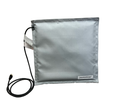
$461.99 USD
18×18 High-Temp Curing Blanket
For an efficient way to cure your epoxy resins faster despite cold weather, consider using a curing blanket from Heat Authority. These blankets provide consistent heat and help achieve maximum strength.







